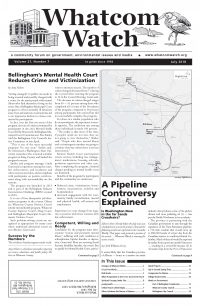by Robert A. Duke
Whatcom County, WA vs. La Crosse County, WI
Because 96 percent of people who die in La Crosse, WI. are claimed to have an advance directive (AD), Whatcom Alliance for Health Advancement (WAHA) publicized La Crosse’s achievement as its own AD goal in 2012.
Nationally, today, only 30 percent of U.S. adults who die have an AD or similar documentation, according to Wikipedia, updated Feb. 24, 2018. WAHA’s goal remains 96 percent.
Is La Crosse’s claim realistic for Whatcom?
First of all, it is implausible to believe the statistic of 96 percent of people anywhere will agree on anything, even in Wisconsin. If a statistic sounds too good to be true, it probably is.
Nevertheless, not just in Whatcom County, but across the U.S., La Crosse’s 96 percent has been cited in the media numerous times going back to 1991. It’s a narrowly accurate statement which has been repeated by a 2010 Dartmouth Atlas Study of Gundersen Health Systems, by johntorinus.com in 2011; by pbs.org on March 16, 2012; by a 2014 Forbes Magazine White Paper; by NPR March 5, 2014; and by PeaceHealth St. Joseph Medical Center staff on Jan. 17, 2018.
Second, effective propaganda can be fabricated from misused and abused statistics, thanks to wishful thinking, media commissions and omissions and apples and oranges comparisons.
“There are three kinds of lies: lies, damned lies and statistics,” as often cited by Mark Twain.
I don’t believe anyone’s lying. But looking into it, it sure looks like that old bogyman statistics is to blame. Gundersen Health Systems was the authoritative source of the 96 percent. Those who adopted and repeated the 96 percent probably didn’t look into the circumstances and calculations that went into creating the claim. I did, but without access to the original source data. There is enough publicly available information, though, to determine the 96 percent was achieved under unique circumstances and the same results would require the same circumstances.
Whatcom County
Since 2012, Whatcom healthcare has aspired to equal the ballyhooed La Crosse record. That effort continues today with enthusiasm and determination to achieve what appears to be an unachievable goal — a statistical mirage. I can find no numbers to quantify Whatcom’s AD adoption efforts over the past six years — no goals, no annual adoption results and no administrative management targets or achievements. Worse than no information about local efforts is the ongoing reliance on the La Crosse number for Whatcom’s efforts despite no validation. At my May 3, 2018, meeting with WAHA’s leadership, it was unable to provide measurements of its AD adoption program. Asked whether leadership thought Whatcom might have already achieved the national adoption average of 30 percent, it had no answer.
Asked about a source of funding and the size of the budget for the adoption program, it had no answer. Asked what adoption goal was in place for 2018, it had no answer. Asked whether it thought La Crosse’s 96 percent adoption claim was realistic for Whatcom, it answered, “No.”
History Repeating Itself
Why this controversy now?
The established WAHA AP project continues in its sixth year, and PeaceHealth St. Joseph Medical Center has also entered the fray with its own Advance Care Plan (ACP) — equivalent to AD project — which appears to me to be redundant since there is no statement of purpose and scope. PeaceHealth publicly repeated the LaCrosse 96 percent adoption goal in January 2018. While PeaceHealth has staffed and funded its new effort, I’ve heard of no measurable goals. It seems to be following the same path as the WAHA project, with all the same questions unanswered, the main one being the dilemma: How can such projects be funded without methods of measuring need or results?
Whatcom vs. La Crosse: How to Find Answers
Resolving this dilemma requires defining and quantifying the project’s elements to achieve a coherent description for comparing, managing and communicating about Whatcom ACP projects. My goal is to enable an apples-to-apples comparison so that when we talk comparisons we can measure the project’s size, cost and complexity.
For clarification, I propose adopting a few assumptions:
• The place La Crosse applies to La Crosse County, WI (so as to compare it to Whatcom County, WA). n Demographic percentages are generally stated per capita (even though there are decedents for whom an ACP does not apply.)
• Decedents are those who die in a hospital, which facilitates counting identifiable individuals with a validated ACP on file.
• ACP validity is a quality-based variable because there are degrees of compliance with directives depending on whose opinion is being expressed (provider, patient or caregiver), which results in differences in the percentage of decedent participation (from 92 percent to 96 percent for La Crosse).
• Nationwide ACP adoption of 30 percent of adults is undefined and may not be comparable to the LaCrosse population. Are the nationwide adults even decedents? If they are decedents, where was their death recorded and by whom?
• Physicians emphasize end-of-life planning when they expect a patient to die in the next 12 to 24 months. This emphasis on prospective decedents populates the statistics with highly motivated adopters of ACPs. What is the general population to which the comparisons are applied?
How Do Whatcom and La Crosse Counties Compare?
Whatcom has approximately twice the population of La Crosse County, but they are otherwise similar and are a suitable relevant comparison.
Whatcom
Economy – medical, education, agriculture.
Population – 221,404, July 2017. Elderly – 65 and over 16.6 percent.
College degree – 32.6 percent.
Hospitals 1 – (PeaceHealth St. Joseph).
La Crosse
Economy – medical, government, education.
Population – 118, 274, July 2017
Elderly – 65 and over 15.6 percent.
College – degree 32.5 percent.
Hospitals – 2 (Mayo and Gundersen)
If Whatcom County reached the national average of 30 percent of decedents with an ACP, then 550 of 1,723 decedents (8 percent of the population of 216,000) would have had an ACP in 2016 (Washington State Vital Statistic for 2016).
In La Cross County there were 955 deaths from all causes reported in September 2016. If La Crosse ACP adoption were the national average of 30 percent, then only 300 decedents from a 2016 population of 118,274 would have adopted an ACP. But, if as claimed by Gundersen and other sources, 96 percent of La Crosse decedents had adopted an ACP, then 916 decedents would have had an ACP (dhs.wisconsin.gov).
During this same period, comparing Whatcom decedents with La Crosse decedents, as a percentage of each’s per capita population, deaths from all causes equaled 8 percent, further emphasizing similarities between the two counties.
Suggested Questions
• Where does Whatcom’s ACP adoption rank nationally: above or below 30 percent?
• What Whatcom decedents, exactly, are we talking about when measuring ACP adoption?
• Are the numbers attributed to La Crosse for Gundersen hospital or does the 96 percent of decedents include the Mayo Clinic hospital?
• Since Gundersen has turned its ACP success into a profit center, what data is Gundersen supplying hospital clients about its ACP adoption expertise?*
Suggested Answers
• Whatcom’s St. Joseph Medical Center can provide some answers by comparing decedent inpatient names with ACPs on file for a recent 12-month period.
• Determine an acceptable and affordable ACP adoption goal given Whatcom’s resources and means.
• Identify, collect and publicly report data which accurately measures Whatcom adoption results and compare Whatcom data to equivalent benchmark data provided by La Crosse or another source.
• Records indicate Gundersen Health System achieved above- average ACP adoption by the focusing the attention of professional staff on assisting patients and community members on end-of-life planning. With Medicare now reimbursing physicians for end-of-life counseling and Whatcom’s PeaceHealth now entering the ACP adoption fray, there may be a new opportunity to achieve ACP adoption closer to La Crosse’s.
*La Crosse’s ACP project was developed into a curriculum titled Gundersen Health System’s Respecting Choices Organization & Community Advance Care Planning Course, which is on Gundersen’s web site at (https://respectingchoices.org/about-us/history-of-respecting-choices) and appears to be a for-profit consulting service.
____________________________________
Robert A. Duke is author of “Waking Up Dying: Caregiving When There Is No Tomorrow,” and lives in Bellingham. His email: boshduke@gmail.com





























